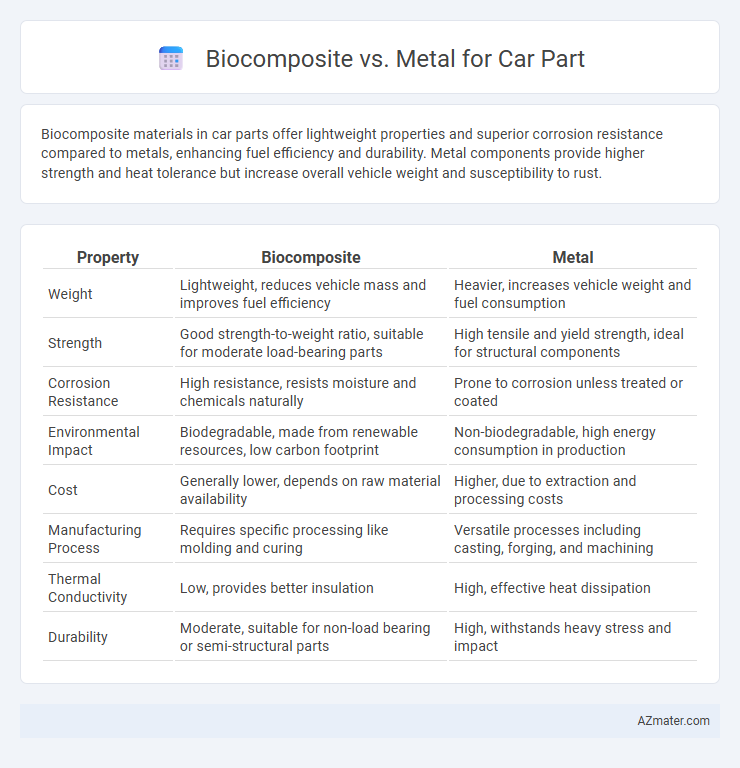Biocomposite materials in car parts offer lightweight properties and superior corrosion resistance compared to metals, enhancing fuel efficiency and durability. Metal components provide higher strength and heat tolerance but increase overall vehicle weight and susceptibility to rust.
Table of Comparison
| Property | Biocomposite | Metal |
|---|---|---|
| Weight | Lightweight, reduces vehicle mass and improves fuel efficiency | Heavier, increases vehicle weight and fuel consumption |
| Strength | Good strength-to-weight ratio, suitable for moderate load-bearing parts | High tensile and yield strength, ideal for structural components |
| Corrosion Resistance | High resistance, resists moisture and chemicals naturally | Prone to corrosion unless treated or coated |
| Environmental Impact | Biodegradable, made from renewable resources, low carbon footprint | Non-biodegradable, high energy consumption in production |
| Cost | Generally lower, depends on raw material availability | Higher, due to extraction and processing costs |
| Manufacturing Process | Requires specific processing like molding and curing | Versatile processes including casting, forging, and machining |
| Thermal Conductivity | Low, provides better insulation | High, effective heat dissipation |
| Durability | Moderate, suitable for non-load bearing or semi-structural parts | High, withstands heavy stress and impact |
Introduction to Biocomposites and Metals in Automotive Applications
Biocomposites are materials composed of natural fibers reinforced with polymer matrices, offering lightweight and environmentally friendly alternatives in automotive parts. Metals such as steel and aluminum remain dominant due to their high strength, durability, and proven performance in structural components. Automotive applications increasingly explore biocomposites for interior panels and non-load-bearing elements to reduce vehicle weight and carbon footprint while maintaining safety and functionality.
Material Properties: Strength, Durability, and Weight
Biocomposites offer a significant weight reduction compared to metals, providing up to 50% lighter alternatives while maintaining competitive strength levels through natural fiber reinforcements like flax or hemp. Metals such as steel and aluminum exhibit superior durability and tensile strength, with steel reaching tensile strengths over 400 MPa and aluminum alloys around 300 MPa, but they contribute to increased vehicle weight and reduced fuel efficiency. Biocomposites enhance impact resistance and corrosion resistance due to their organic matrix, though they often require surface treatments to improve long-term durability in automotive environments.
Environmental Impact and Sustainability
Biocomposite car parts significantly reduce environmental impact by utilizing natural fibers and biodegradable resins, lowering carbon emissions compared to traditional metals. These materials promote sustainability through renewable sourcing and decreased energy consumption during production and recycling phases. Metal components, while offering durability, often involve higher mining-related pollution and energy-intensive manufacturing, leading to a larger ecological footprint.
Cost Analysis: Manufacturing and Lifecycle Expenses
Biocomposites offer considerable cost savings in manufacturing due to lower raw material expenses and reduced energy consumption compared to metals like steel or aluminum, which require intensive mining and processing. Lifecycle expenses for biocomposite car parts are generally lower because of their corrosion resistance and lighter weight, leading to improved fuel efficiency and reduced maintenance costs. However, metals provide superior durability and recyclability, which can offset initial cost benefits through longer service life and established recycling infrastructure.
Performance in Real-World Conditions
Biocomposites offer superior corrosion resistance and reduced weight compared to metals, critical for enhancing fuel efficiency and reducing emissions in automotive applications. Metals provide higher tensile strength and impact resistance, ensuring durability under extreme mechanical stress and high-temperature conditions encountered in real-world driving. Performance in real-world conditions depends on the specific part's requirements, with biocomposites excelling in vibration dampening and metals excelling in load-bearing capacity.
Design Flexibility and Aesthetic Possibilities
Biocomposites offer superior design flexibility compared to metals, allowing complex shapes and intricate textures that enhance aesthetic appeal without compromising structural integrity. The lightweight nature of biocomposites enables innovative, ergonomic designs while maintaining sustainability standards in automotive manufacturing. Metals, while robust and durable, often require heavier and more rigid designs, limiting creative freedom and aesthetic variation.
Recycling and End-of-Life Considerations
Biocomposites in car parts offer superior recyclability compared to metals, as they are derived from renewable resources and can be composted or biodegraded, reducing landfill waste. Metals, while highly recyclable through established smelting processes, demand significant energy and produce emissions during recycling, impacting environmental sustainability. End-of-life strategies for biocomposites emphasize circular economy principles, enabling material recovery and reuse with lower carbon footprints than traditional metal recycling.
Case Studies: Industry Adoption and Success Stories
Case studies reveal biocomposite car parts reduce vehicle weight by up to 30%, enhancing fuel efficiency and lowering emissions compared to traditional metals like steel and aluminum. Automotive leaders such as Ford and BMW have successfully integrated biocomposites in door panels and interior trims, achieving cost savings and improved sustainability metrics. These industry examples demonstrate biocomposites' growing role in reducing carbon footprints while maintaining mechanical performance in mass production.
Challenges and Limitations of Each Material
Biocomposites face challenges such as lower mechanical strength, moisture sensitivity, and variability in natural fiber quality, which can affect durability and performance in car parts. Metals offer superior strength and heat resistance but pose limitations due to higher weight, susceptibility to corrosion, and increased manufacturing energy consumption. Both materials require optimization to balance cost, environmental impact, and functional longevity in automotive applications.
Future Trends: Innovations and Market Outlook
Biocomposites are gaining traction in the automotive industry due to their lightweight properties, sustainability, and potential for reducing carbon footprints compared to traditional metals. Innovations in nanocellulose reinforcement, bio-resins, and 3D printing technologies are enhancing the mechanical performance and cost-effectiveness of biocomposite car parts. Market forecasts predict significant growth in biocomposite usage, driven by stricter environmental regulations and consumer demand for eco-friendly vehicles, challenging the dominance of metals in structural and interior automotive components.

Infographic: Biocomposite vs Metal for Car Part
 azmater.com
azmater.com